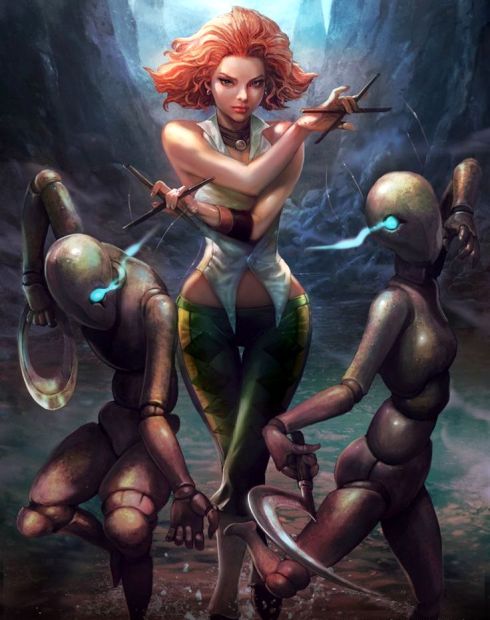Difference between revisions of "Puppetry (sage field)"
Tao alexis (talk | contribs) (Created page with "'''Puppetry''' is a sage field available to bards, depicting a form of theatre that involves the making and manipulation of puppets and other i...") |
Tao alexis (talk | contribs) |
||
| (7 intermediate revisions by 2 users not shown) | |||
| Line 1: | Line 1: | ||
| − | '''Puppetry''' is a [[Sage Field|sage field]] available to [[Bard (class)|bards]], | + | [[File:Puppetry (field).jpg|right|490px|thumb]] |
| + | '''Puppetry''' is a [[Sage Field|sage field]] available to [[Bard (class)|bards]], represents a theatrical art form centered around crafting and manipulating puppets and other lifeless objects to craft compelling dramatic performances. With deep historical roots, puppetry holds a dual role as ritualistic objects and symbolic works of art. The practice boasts a rich and storied history that transcends cultures and spans centuries. | ||
__TOC__ | __TOC__ | ||
| − | + | This includes the meticulous construction of puppets which take various forms, such as hand puppets, marionettes, shadow puppets and more. For example, Wayang Kulit, a traditional Japanese shadow puppetry form, combines elements of spirituality and storytelling as it brings epic tales to life. Puppets have also played significant roles in rituals and ceremonies. They serve as intermediaries between the human and the divine, conveying messages and blessings. In some cultures, puppetry is intertwined with religious practices, as puppets are used to represent gods, ancestors, or mythical beings during sacred rites. | |
| − | * '''[[Effigy (sage study)]]''': the | + | Each puppet is a masterpiece, meticulously crafted to convey not only a character but also cultural aesthetics and artistic expression. |
| + | <br> | ||
| + | |||
| + | == Studies == | ||
| + | '''The field''' includes the following [[Sage Study|sage studies]]: | ||
| + | |||
| + | :* '''[[Effigy (sage study)]]''': the art of imbuing figures and objects with spiritual essence and divine vitality, sometimes even bestowing animation upon typically lifeless entities. While akin to dweomercraft, it maintains its own distinct characteristics and is closely connected to the creation of golems. | ||
| − | * '''[[Puppeteering (sage study)]]''': the | + | :* '''[[Puppeteering (sage study)]]''': the art of bringing a puppet to life through a diverse array of methods, including the use of strings, hands, manipulation of the puppet's stage, diversion, and the skillful mastery of the puppet's movements. |
| − | * '''[[Puppet-making (sage study)]]''': the | + | :* '''[[Puppet-making (sage study)]]''': crafting the puppet's shape and form, often resembling a living being or humanoid, using a range of materials, with the intention of enabling its manipulation through various methods. |
<br> | <br> | ||
See [[Bard Sage Abilities]] | See [[Bard Sage Abilities]] | ||
| − | [[Category: | + | [[Category: Reviewed]] |
Latest revision as of 17:49, 20 October 2023
Puppetry is a sage field available to bards, represents a theatrical art form centered around crafting and manipulating puppets and other lifeless objects to craft compelling dramatic performances. With deep historical roots, puppetry holds a dual role as ritualistic objects and symbolic works of art. The practice boasts a rich and storied history that transcends cultures and spans centuries.
Contents
This includes the meticulous construction of puppets which take various forms, such as hand puppets, marionettes, shadow puppets and more. For example, Wayang Kulit, a traditional Japanese shadow puppetry form, combines elements of spirituality and storytelling as it brings epic tales to life. Puppets have also played significant roles in rituals and ceremonies. They serve as intermediaries between the human and the divine, conveying messages and blessings. In some cultures, puppetry is intertwined with religious practices, as puppets are used to represent gods, ancestors, or mythical beings during sacred rites.
Each puppet is a masterpiece, meticulously crafted to convey not only a character but also cultural aesthetics and artistic expression.
Studies
The field includes the following sage studies:
- Effigy (sage study): the art of imbuing figures and objects with spiritual essence and divine vitality, sometimes even bestowing animation upon typically lifeless entities. While akin to dweomercraft, it maintains its own distinct characteristics and is closely connected to the creation of golems.
- Puppeteering (sage study): the art of bringing a puppet to life through a diverse array of methods, including the use of strings, hands, manipulation of the puppet's stage, diversion, and the skillful mastery of the puppet's movements.
- Puppet-making (sage study): crafting the puppet's shape and form, often resembling a living being or humanoid, using a range of materials, with the intention of enabling its manipulation through various methods.
